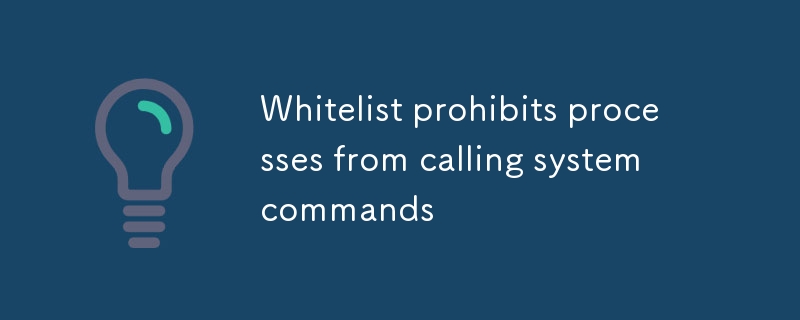화이트리스트는 프로세스가 시스템 명령을 호출하는 것을 금지합니다.
이 문서에서는 시스템 명령을 호출하지 못하도록 금지된 프로세스를 화이트리스트에 추가하는 방법에 대해 설명합니다. 금지된 프로세스를 화이트리스트에 추가하면 중요한 시스템 명령에 대한 무단 액세스를 방지하여 보안 위반 및 데이터 유출을 줄이는 데 도움이 됩니다. 이 기사에서는

시스템 명령 호출에서 금지된 프로세스를 화이트리스트에 추가
시스템 명령 호출에서 금지된 프로세스를 화이트리스트에 추가하는 방법?
시스템 명령 호출에서 금지된 프로세스를 화이트리스트에 추가하려면 를 사용할 수 있습니다. auditd 도구를 사용하면 특정 프로세스가 특정 명령을 실행하도록 허용하는 규칙을 만들 수 있습니다. 방법은 다음과 같습니다.auditd tool to create a rule that allows specific processes to execute certain commands. Here's how you can do it:
-
Create a rule file: Create a file called
/etc/audit/rules.d/whitelist.ruleswith the following content:
<code>-w /usr/bin/command -p x -c never</code>
In this rule, /usr/bin/command is the command that you want to whitelist, -p x specifies that the rule applies to processes with executable permission, and -c never specifies that the rule should never be enforced. You can add multiple rules to the file, each on a separate line.
-
Load the rules: Load the rules file into the
auditdsystem by running the following command:
<code>sudo auditctl -R /etc/audit/rules.d/whitelist.rules</code>
-
Restart
auditd: To ensure that the rules are applied immediately, restartauditdby running:
<code>sudo systemctl restart auditd</code>
What are the benefits of whitelisting forbidden processes?
Whitelisting forbidden processes can help prevent unauthorized access to sensitive system commands. By restricting the ability of certain processes to execute specific commands, you can reduce the risk of security breaches and data leaks.
What are some examples of forbidden processes?
Forbidden processes are typically processes that are not essential for the operation of the system and that could be used to compromise the system if they were allowed to execute certain commands. Examples of forbidden processes include:
- Processes that have excessive file permissions
- Processes that are running with root privileges
- Processes that are known to be vulnerable to exploits
How can I audit forbidden processes?
You can audit forbidden processes by using the auditctl tool. To do this, run the following command:
<code>sudo auditctl -w /usr/bin/command -p x -c id</code>
This command will create an audit rule that logs all attempts by processes with executable permission to execute the /usr/bin/command
- 규칙 파일 만들기:🎜 다음 내용이 포함된
/etc/audit/rules.d/whitelist.rules라는 파일을 만듭니다.
<code>sudo cat /var/log/audit/audit.log | grep /usr/bin/command</code>
/usr/bin/command는 허용 목록에 추가하려는 명령이고, -p x는 규칙이 적용되는 대상을 지정합니다. 실행 권한이 있는 프로세스이며 -c never는 규칙이 적용되지 않도록 지정합니다. 파일에 여러 규칙을 각각 별도의 줄에 추가할 수 있습니다.🎜- 🎜규칙 로드:🎜 다음을 실행하여 규칙 파일을
auditd시스템에 로드합니다. 다음 명령:
- 🎜
auditd다시 시작:🎜 규칙이 즉시 적용되도록 하려면auditd를 다시 시작하세요.실행:
- 과도한 파일 권한이 있는 프로세스
- 루트 권한으로 실행되는 프로세스
- 악용에 취약한 것으로 알려진 프로세스
auditctl 도구를 사용하여 금지된 프로세스를 감사할 수 있습니다. 이렇게 하려면 다음 명령을 실행하세요.🎜rrreee🎜이 명령은 /usr/bin/command 명령을 실행하기 위한 실행 권한이 있는 프로세스의 모든 시도를 기록하는 감사 규칙을 생성합니다. 다음 명령을 실행하여 감사 로그를 볼 수 있습니다.🎜rrreee위 내용은 화이트리스트는 프로세스가 시스템 명령을 호출하는 것을 금지합니다.의 상세 내용입니다. 자세한 내용은 PHP 중국어 웹사이트의 기타 관련 기사를 참조하세요!

핫 AI 도구

Undresser.AI Undress
사실적인 누드 사진을 만들기 위한 AI 기반 앱

AI Clothes Remover
사진에서 옷을 제거하는 온라인 AI 도구입니다.

Undress AI Tool
무료로 이미지를 벗다

Clothoff.io
AI 옷 제거제

AI Hentai Generator
AI Hentai를 무료로 생성하십시오.

인기 기사

뜨거운 도구

메모장++7.3.1
사용하기 쉬운 무료 코드 편집기

SublimeText3 중국어 버전
중국어 버전, 사용하기 매우 쉽습니다.

스튜디오 13.0.1 보내기
강력한 PHP 통합 개발 환경

드림위버 CS6
시각적 웹 개발 도구

SublimeText3 Mac 버전
신 수준의 코드 편집 소프트웨어(SublimeText3)

뜨거운 주제
 7546
7546
 15
15
 1382
1382
 52
52
 83
83
 11
11
 57
57
 19
19
 21
21
 90
90


